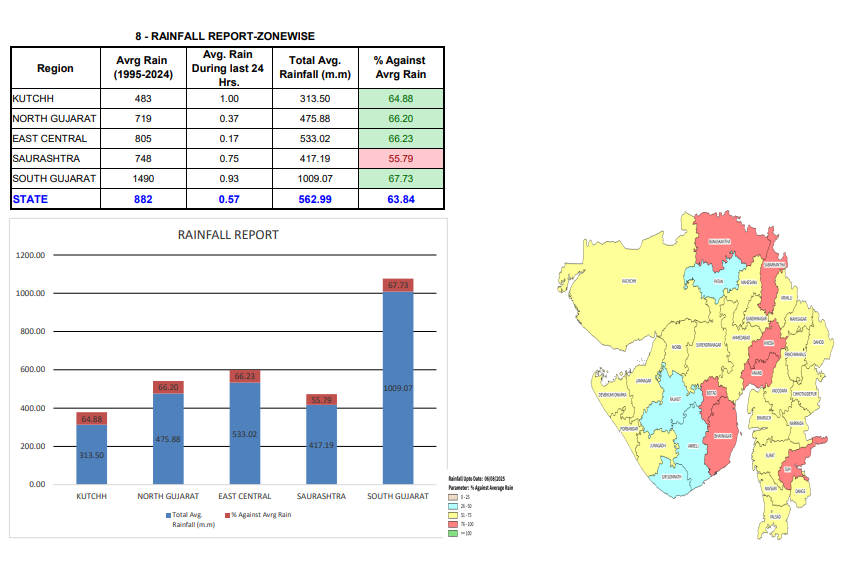August Brings Monsoon Delay in Gujarat; Saurashtra Hit Hardest
August 06, 2025
Gandhinagar: The state has been experiencing slightly warmer days as the monsoon rains have taken a pause over the past two weeks. According to data from the State Emergency Operations Centre (SEOC), out of 251 talukas in Gujarat, only 45 received some showers on Tuesday. However, the rainfall was very scattered and light, with the highest 10 mm recorded in Pardi.
Earlier days had seen better rainfall, but the situation has changed, particularly in the Saurashtra region, which has not witnessed significant rainfall for the past two weeks. The delayed monsoon has increased concern among farmers in Saurashtra, as there is now a rainfall deficit in several districts. As of 8 am today, Saurashtra has received only 55.79% of its average seasonal rainfall, amounting to 417.19 mm so far this monsoon season. Notably, the region has not recorded even 1 mm of average rainfall since the beginning of August. According to SEOC data, Saurashtra had received 410 mm of rain on July 27, and since then, it has received just over 7 mm in the last 10 days.
The situation is particularly worrying in districts like Gir Somnath, Rajkot, and Amreli, which have not yet received even 50% of their average seasonal rainfall, with no immediate forecast of heavy showers. Only Botad and Bhavnagar have crossed the 75% mark of their average seasonal rainfall among Saurashtra districts.
Why is the state not getting rain showers?
According to the Indian Meteorological Department, the primary monsoon trough at sea level is currently aligned far to the north of Gujarat, stretching from Punjab to Arunachal Pradesh along the Himalayan foothills.
This positioning means the core monsoon system is not currently active over Gujarat, reducing the likelihood of widespread rainfall in the state.
Furthermore, a secondary trough extends from north-central Uttar Pradesh to northern Kutch, passing through east Rajasthan and north Gujarat, but this exists at mid-tropospheric levels.
Unfortunately for Saurashtra, this secondary trough might bring only localized weather activity, such as isolated showers or increased humidity, primarily in north Gujarat and Kutch.
Without strong support from the main monsoon trough or a low-pressure system, significant rainfall appears unlikely in the near future.
Kharif Sowing and Government Response to Monsoon Delay
As of August 4, Gujarat has completed sowing across 70.47 lakh hectares under various Kharif crops this year, which is 82.35% of the state’s normal Kharif sowing target of 85.57 lakh hectares. Among the top five districts with the highest sown area, Surendranagar leads with 5.51 lakh hectares, followed by Amreli with 5.49 lakh hectares, and Kutch with 5.41 lakh hectares. Rajkot (5.09 lakh hectares) and Banaskantha (4.64 lakh hectares) also figure in the top five.
Given that three of the top five districts are in the Saurashtra region—which accounts for a major portion of the state’s sown area—the continued delay in monsoon rainfall is becoming a cause of concern for farmers.
In response to the prolonged monsoon delay and growing public concern, the Gujarat government has announced that additional Narmada water will be supplied to Saurashtra via the SAUNI scheme, benefiting both farmers and residents.
Furthermore, the government stated that if required, North Gujarat may also be provided water through the Sujalam Sufalam scheme, depending on future rainfall patterns and public needs. DeshGujarat
Related Stories
Recent Stories
- PM Modi proposes Thiru CP Radhakrishnan Ji's nomination for the Vice President
- India operates 24 nuclear power reactors with 8,180 MW capacity: Centre
- Closure of Tapi Bridge on Ahmedabad–Mumbai Highway Extended till Aug 20
- Pakistani Mohalla in Surat renamed to Hindustani Mohalla
- Multiple rounds of heavy rains likely in Saurashtra, Kutch, during 16-23 August: Weather analyst
- NHAI Rolls Out FASTag Annual Pass; List of Eligible Toll Plazas in Gujarat
- PM Modi announces Mission Sudarshan Chakra; aims to boost national security shield by 2035
